Recent Posts
-
Real Crimes and the Coming Violence
September 6, 2025
-
Whither Modern Life?
June 27, 2025
-
What the Hell
June 18, 2025
-
As Darkness Engulfs Us
April 6, 2025
-
AI, Risk, and Work
January 17, 2025
-
“Things Are in the Saddle, and Ride Mankind”
December 29, 2024
-
Forgotten Futures in Seattle
December 12, 2024
-
Autocracy Defeats Neoliberalism
November 14, 2024
-
History… We’re Soaking in It!
October 2, 2024
-
A Numbing Spectacle
September 22, 2024
|
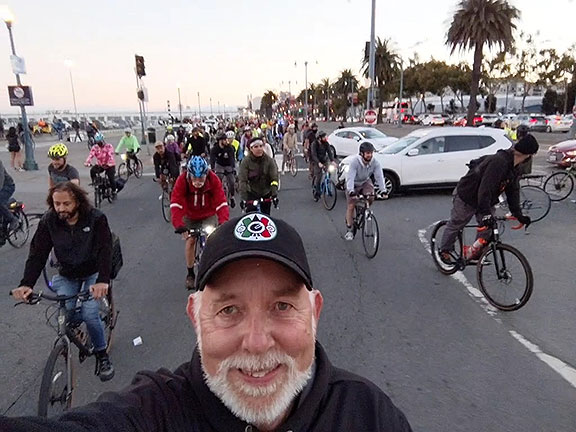 Rolling along the Embarcadero, after filling both sides of the boulevard almost to the Giants stadium, early during the 30th anniversary ride Sept. 30, 2022. Hard to believe, but it’s been 30 long years since we first “rode home together” up Market Street and straight to Zeitgeist. The ride September 30 was spectacular, joyous, euphoric, memorable, inspiring, and a surprising throwback to the best of the experiences of the past. Surprising because I had no expectations of a large ride, nor that there would be a groundswell of excitement in the days leading up to it. But in fact, it happened.
I wrote an op-ed that the SF Examiner managed to screw up. Not only did the editor insert a false claim (that there is an official organization called Critical Mass) but she put it where I was clearly referring to the SF Bike Coalition with a critical comment. And I didn’t even want to name them, feeling that anyone who cares already knows, and for the rest it wasn’t important. And then to top it off, when they printed the article and one of my photos in the print version last Wednesday, they deliberately miscaptioned my photo. Man! Last time I do anything for them!
In better coverage during and after the event last Friday, LisaRuth and Hugh did a great job on the Roll Over Easy podcast (starts about an hour in). KQED did a fair job of covering it, and Steve Jones gave a good account on 48hills. And big kudos to Jim Swanson for writing down his own memories of the earliest beginnings of Critical Mass—a vital account we’ve needed for a long time!
Overall I loved the energy. Dozens and dozens of oldtimers and a huge number of people who said it was there first ever too. And so many people did such a good job of corking at all the intersections, if only the front of the ride had kept it slower and more compacted, it would’ve been nearly perfect. As it was, it was very very good for the first hour or so. Eventually it fell apart going back and forth through Broadway Tunnel, though it recovered a dense mass a while later at Union Square. Once the ride got to City Hall, it turned into a Bike Party for a lengthy dance stop. That’s when I took off to Dolores Park to meet up with the OGs who had planned to rendezvous there, just like it was 25 years ago… I took a ton of photos of friends, so I’m going to post a huge gallery of images here.
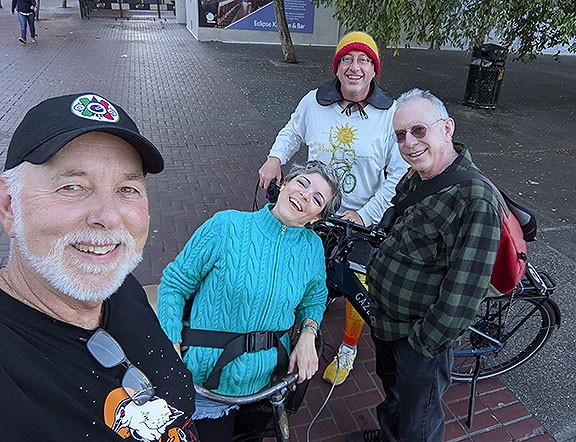 On my way to the Embarcadero I ran into Joel! And when we rolled in around 5:20 who did we see first but Beth and Jon! And then Larry showed up a few minutes later! It set the night off on the right foot, a reunion and a celebration! I’ve written a lot about the death of bike culture in San Francisco, and the long expiration of Critical Mass hereabouts. I stand by all that, but for one night, it was as magical and inspiring as it has ever been. It’s hard to say how many of us felt restored, a kind of deep sigh of “oh, well, we’re still here! It’s STILL San Francisco after all!” Congrats everyone, and thank you to all of you. I’m not captioning any of the many photos to follow. You know who you are!
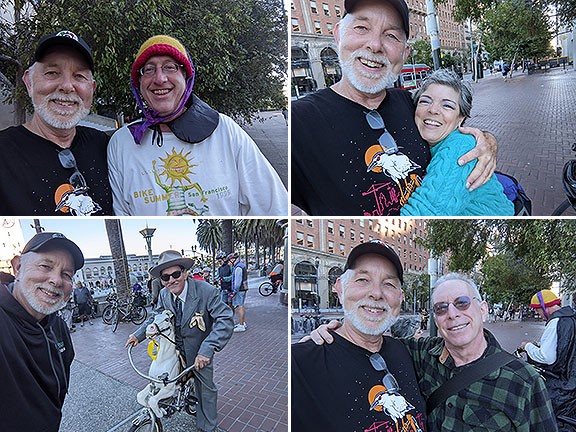
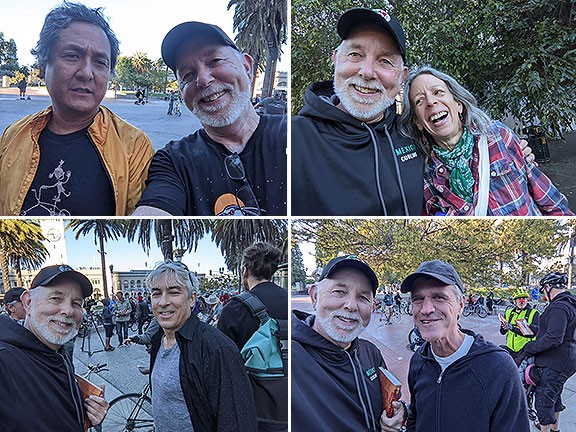
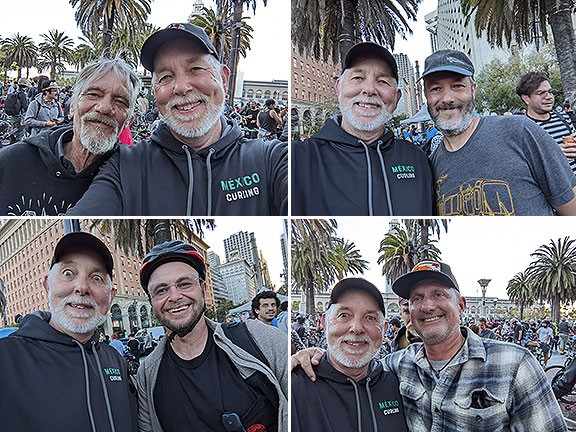
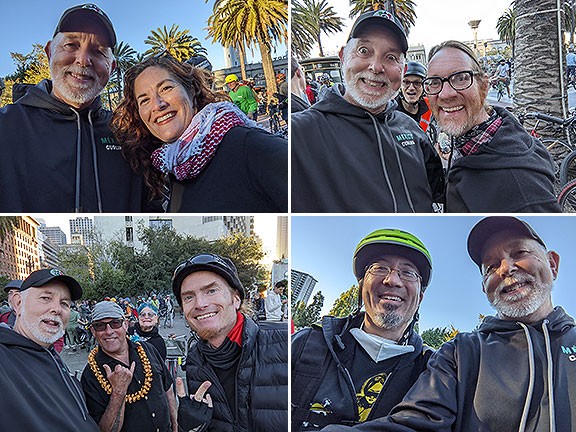
Continue reading Critical Mass San Francisco Turns 30 Years Old!
 My first night in Austin after the 100 degrees cooled off a bit, we had a beautiful ride organized by Ride Bikes Austin… went along the Colorado River and saw the bats! I’ve fallen in inconsequential ways a few times in my bicycling life. I was doored once but didn’t fall, and nearly doored a dozen times, always escaping by the skin of my (lucky) teeth. Somehow it was in Austin, Texas, on a blazing 103-degree Saturday afternoon, rolling along at 7 mph on a wide, flat dirt path along the river, looking everywhere but in front of me, that I found myself plunging into a small but real drainage ditch. The front wheel was mangled, and I flew into the handlebars and smashed into the ground. I got up scraped and seeing stars for a moment, the 4th finger on my left hand weirdly bent at the top knuckle, and felt a sharp pain in my chest. Broken rib? Cracked sternum?
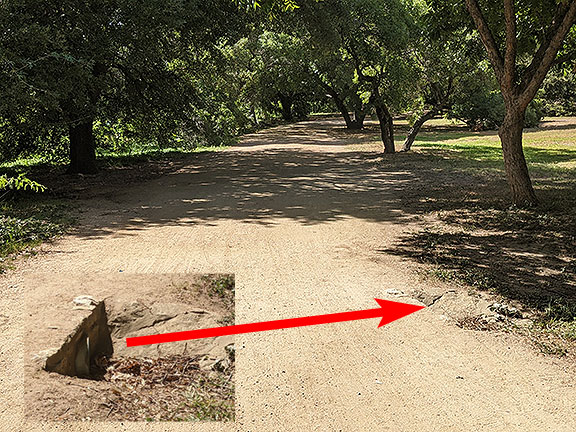 That invisible ditch, highlighted in box at left, is what got me… I can’t believe it! Not wanting to risk a $35,000 ER bill from a Texas hospital I went back to my friends’ place and decided to fly home early the next morning. Adriana took me from the airport directly to the Kaiser ER, where xrays and EKG and a full exam concluded that I had nothing broken, no heart or lung problems, but a bad chest contusion, and “mallet finger.” Tomorrow I’ll get some more medical attention for my finger, which is really inhibiting my ability to type this, or to continue my steady pace of writing my new novel (which is why I’ve not been blogging for a while). So I had a real wreck! Dammit!
This past weekend I was invited to come to Austin by Raquel Ortega and Nona Allen of Ride Bikes Austin and the resuscitated Critical Mass there, who also gave me their couch and arranged a bicycle from the Austin Yellow Bike Project (thank you Pete and Dot!). It was a sweet experience, great to see Austin, albeit in an oddly fragmented (and very brief) way. I met a bunch of lovely folks on the two rides, Thursday and Friday evenings.
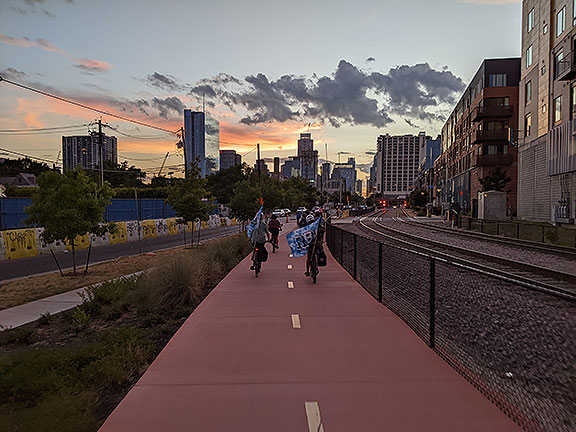 Lots of new bike paths that I got to sample a bit of during the two nights I got to ride… missed out on a third night due to my crash. I have to say, I’m a bit surprised to have my peripatetic “Critical Mass diplomat” role suddenly come back to life. Maybe it’s because this is the 30th anniversary year, but there has been a notable uptick in attention and people reaching out to me, from Texas to Porto Alegre, Brazil, to major press outlets in Germany. Doesn’t alter the basic reality that here in San Francisco bicycling culture is almost kaput. Still lots of cyclists but no particular culture that foregrounds bicycling as a political or even important social choice. I’ve accepted that for years now.
But I’d say we did our part in shifting sensibilities, in permanently altering what passes for common sense. Whether or not most people choose to bicycle as their main mode of urban transportation is not so crucial—that probably won’t happen until there really are no easier alternatives—which may never come to pass. That’s ok. I know there are plenty of cyclist activists who are true believers—crusaders if you will—for their preference as the correct choice. I’ve never been there. I prefer to use a bicycle to get around. It’s easier and quicker and more pleasurable AND efficient FOR ME. And for many others. But not for everyone—of course!
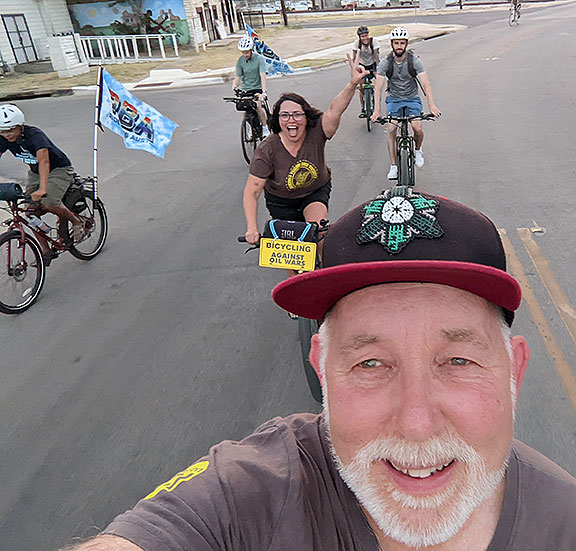 That’s Raquel Ortega behind me, and Nona Allen just to the left with the banner. Lovely hosts! I would argue Critical Mass and Occupy and a variety of other social movements have importantly contributed to deeper contemporary change at a basic philosophical—even, perhaps epistemological—level. As evidence, I was struck while passing through the airport to see these books facing out from the bookshop there. I left the interesting ones in color to help identify them.
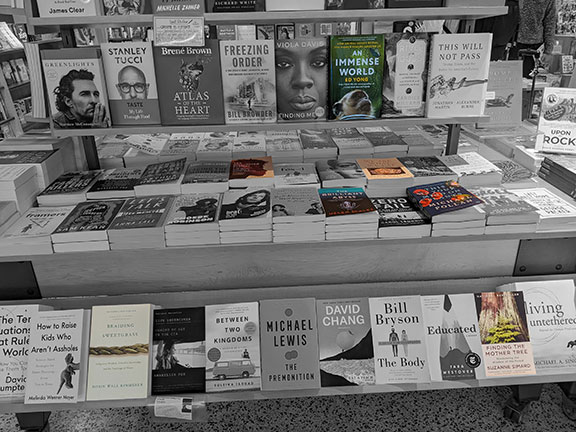 Books in color correspond to some of the ones cited below, but all are evidence of a shifting paradigm in our culture. I finally read Braiding Sweetgrass a couple of months ago, and as all accounts have it, it’s a beautiful book—deep, soulful, inspiring, wise. Suzanne Simard’s book on the Mother Tree is there too, as is Michael Pollan’s latest on changing your mind with drugs. Further up are several books on the largely overlooked wonders of the deep oceans (which in a horrifying near future scenario, may be subject to a kind of ocean floor strip-mining!) and animal subjectivity and intelligence. Some of this new sensibility is rooted in a growing awareness of the fundamental intelligence of every aspect of the world around us, even things we’ve deemed inanimate. David Abram has written two excellent books that advance a scientifically aware and rationally based argument for animacy. A more broad return to indigenous sensibilities underlies a good deal of these new (old) ways of approaching life on earth. Here is a run of my favorite passages from a bunch of books I read in the past months, including some of the ones just mentioned.
Continue reading Still Reckless, No Longer Wreckless!
I’m deep into writing my new novel, and so not paying much attention to my blog… But here’s a short essay I wrote as an introduction to a pamphlet being published in Porto Alegre, Brazil, by Monstro dos Mares. It’s based on an impromptu speech I gave in a park called Rendencão at the end of a very spirited Critical Mass ride there in 2012. It was during the first World Bike Forum (this year’s is in Manizales, Colombia in case you want to go!). This intro may finally be all I put out for the 30th anniversary of Critical Mass which falls this September, 2022… amazing! (I’m old!)
 During the ride in the middle of the city everyone stopped and began clapping and chanting “Mas Adrenalina, Menos Gasolina” (more adrenaline, less gasoline!) We Can’t Wait!
Much of what we experienced in Porto Alegre back in those celebratory and defiant days a decade ago was vital and thrilling. To be among thousands of other cyclists, reclaiming and reinventing the urban space while we rolled through it, created new spaces in our imaginations. The dull repetitive madness of daily traffic dominated by cars and trucks and buses was forced to give way to a fresh, light, breezy, convivial space invented together by thousands of people who probably did not know each other before arriving at that moment. Critical Mass was a surprisingly successful experiment in inventing a new form to challenge the imposing edifice of modern life. But in all honesty, it wasn’t an experiment that successfully expanded into other realms, nor was it able to sustain itself on that trembling edge of potential indefinitely. In most places, certainly here in San Francisco where it all started 30 years ago, Critical Mass has long passed into irrelevance and obscurity. If it does keep rolling, it is a shell of what it was, an imposter lacking the vital pulse of subversive possibility.
Surprisingly, the amalgamation of ideas and possibilities once embodied in the Critical Mass experience gave way over time to the simple choice that untold millions made to use their bicycle as everyday transportation. The choice to bicycle was a wise and self-rewarding one for most, and today in cities across the planet, hundreds of thousands more people use the bicycle for their everyday transportation than did at the end of the last century. Every ride each day by every rider is as the saying goes, “one less car,” and in aggregate, tons less CO2 being poured into our shared air. But the cultural experience that was so available in decades past, of being a rebel, a subversive, an outlaw, by cycling, has passed into history. No one claims to be a “microwavist” for using a microwave oven, nor are there “hammerists” who use hammers. Similarly, far fewer people today describe themselves as “bicyclists” just because they use a bicycle occasionally or regularly. And that is as it should be, in my opinion. We should not be defined by the devices we use or what we own, but rather by what we do.
The bicycle has proven for many to be a great beginning. It has been a radical break with car and oil dependency, a personal technological choice that embraces the possibilities implicit in making a different decision about how to go from Point A to Point B. But having made that choice to bicycle, how many have gone on to question what actually do at Point A and Point B? For this is the heart of our modern predicament. Every day we wake up and reproduce this world, not the world we could make together if we decided to finally break with the madness of our daily lives. The question we users of bicycles have to confront: If bicycling is the key, what does it unlock? Or put another way, if bicycling is the window we go through first, what is on the other side?
As I said a decade ago in the park in Porto Alegre, bicycling is not enough. If everyone were to ride bicycles in most cities, we would still be destroying the planet in myriad other ways, whether through industrial agriculture, mining, fossil fuel extraction, or crypto-currency “mining.” And our brutality towards climate refugees, towards “others,” whether Black, indigenous, or otherwise, would be untouched, just as our easy acceptance of a world based on incessant economic growth ensures that our rapid destruction of the conditions for life on earth would continue unchecked.
Faced with such enormous obstacles, it is easy to despair and to feel deeply pessimistic. And that’s where we must find that special combination I call “radical patience.” We can’t wait, we must take action every day and in every way to bring about the deep changes we need. But we have to recognize how slowly history moves. We have to maintain our confidence in the face of daunting odds and regular disappointments, while holding the passion and strength to keep pushing for the changes we know are necessary. We have to combine our radical insistence with a deep patience for our fellow beings, knowing that some of us would go faster if we could, while others will always move a lot slower than we’d prefer. Ultimately, we have to do this together, with our friends, family, and neighbors. And we have to find our connections across neighborhoods, between cities, across national frontiers, among watersheds, from mountains to the sea, and including all the inhabitants of earth, not just the human ones! Take a deep breath, and then another. And then carry on!
—April 12, 2022, San Francisco, California
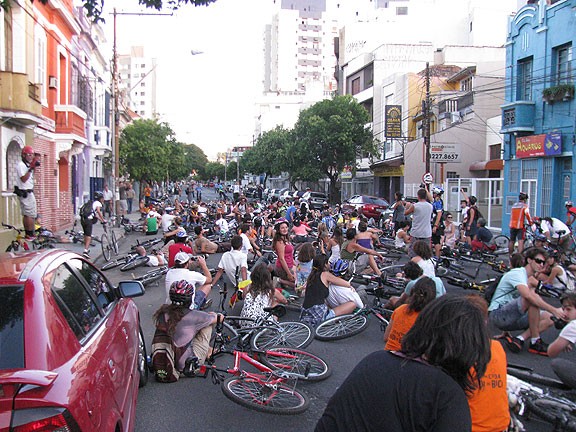 The organizers launched the World Bike Forum to dramatize the event that took place exactly a year earlier, when an impatient banker had plowed through 200 cyclists on the road. Miraculously no one was killed and the injuries weren’t permanent. The banker at the time of the event one year later remained unpunished. Since then I think he was convicted but served little or no time. 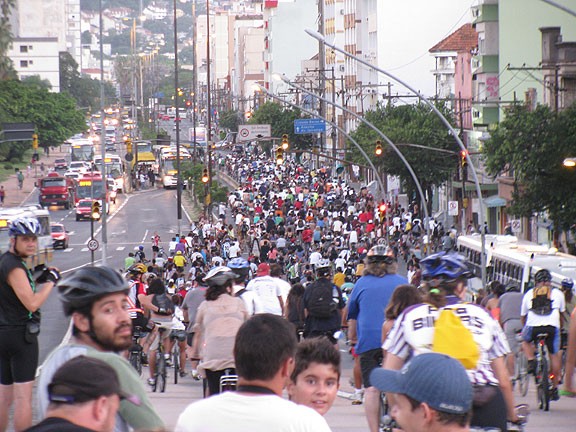 A view from the back… 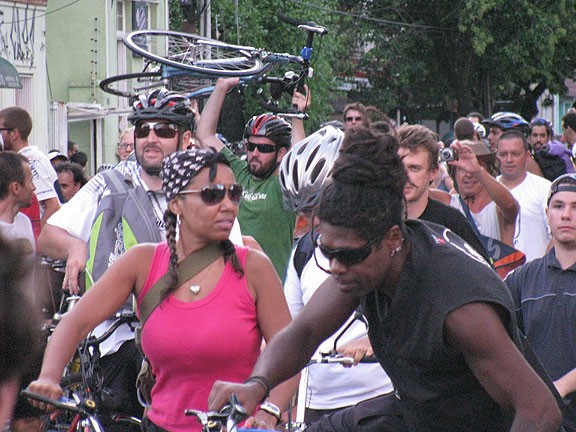 In the middle  And rolling by…
|
Hidden San Francisco 2nd EDITION!

NEW 2nd EDITION NOW AVAILABLE!
Buy one here
(Pluto Press, Spring 2025)
|



























